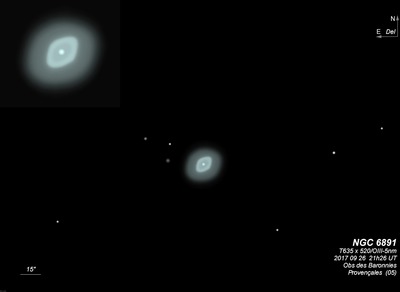
80mm (9/10/07): visible as a faint "star" at 12.5x in the 80mm finder and easy to verify as a planetary by blinking with an OIII filter.
Ralph Copeland discovered NGC 6891 on 22 Sep 1884 at Dun Echt, Scotland, using a direct vision objective-prism (Secchi prism) sweep with a 6.1-inch refractor. He remarked "this seems to be identical with the 9.5 mag star DM +12°4266. It is in reality a planetary nebula about 4" in diameter with a nearly monochromatic spectrum."
Based on Crossley photographs taken at Lick, Heber Curtis (1918) noted, "mag 11.8 central star (Burnham). A round disk 15" in diameter, of which the central 7" is considerably the brighter. From this brighter center extend indistinct traces of wings in p.a. about 135-315°."
200/250mm - 8" (6/29/84): fairly high surface brightness, small blue disk.
400/500mm - 17.5" (8/27/87): very bright at 140x and OIII filter. Appears as a small high surface brightness bluish oval of 10"-15" diameter. At 410x, a brighter center or mag 13 central star is visible. At this magnification, the planetary appears as a bright oval with a fainter outer halo.
600/800mm - 24" (7/1/16): at 375x; very bright bluish disc slightly elongated NNW-SSE, perhaps 10"x8". A fainter outer halo increases the diameter to roughly 18". The mag 12.5-13 central star was steadily visible. A mag 14.5 star is close off the NE edge [17" from center]. At 750x the brighter inner disc seemed more elongated with tapered ends like a lens.
Notes by Steve Gottlieb